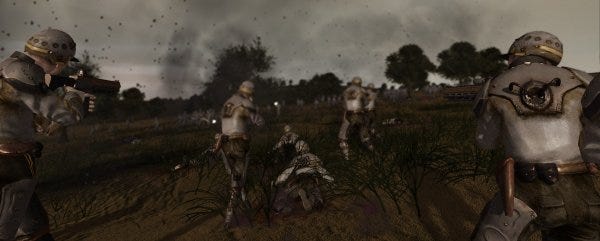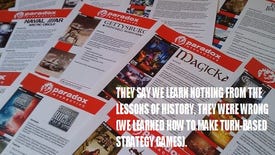Eyes-On: Gettysburg: Armored Warfare
That's armoured without a u
Paradox might have a reputation for being the purveyors of grand and quite serious historically-anchored games, but they are fast becoming the publisher of far less historically fastidious titles. Gettysburg: Armored Warfare's premise is for the American Civil War being refought with weapons from the future. The result is a chaotic-looking multiplayer RTS with battlefields that appear futuristic and 19th-century at the same time. We're talking Civil War gentlemen with large moustaches and mini-guns.
The key developer of Gettysburg, Radioactive Software's Danny Green, might have outsourced some elements of the game, such as the creation of his outlandish ahistorical units, but the game is very much his creation, with him as design lead and sole programmer. That he's got 64-player RTS in which players can seamlessly jump between control of hundreds of units working is remarkable enough, but the game will also ship with a fully-featured map editor and Steam Cloud support.
Purely multiplayer (although with offline bot practice) the game sees players take to four different famed battlefields of the Civil War, refighting the Union vs Confederacy bust ups with a deranged ensemble of tanks, APCs, steamships and Zeppelins. At the start of a match players are able to select armies that include these fantasy units alongside traditional Civil War units such as riflemen, cavalry, and cannons. Realism goes out the window a bit to make these effective against futuristic mobile artillery and submachinegun-wielding troopers, but this is not a game that takes itself particularly seriously. Historical units are also much cheaper to field than their time-travelled counterparts, so there's a limit to how much high-tech you can throw at the skirmishes of the past.

Once in-game, players face one of two game modes: a 64-player mode where the AI-controlled units pour onto the field and anyone on the two teams can take direct control of any soldier, tank, ship or airship out of a possible 1024 on the field, in a vast deathmatch, or a 4-player “Army Skirmish”, in which players control a smaller number of units in direct RTS fashion. Both modes, however, allow you to take direct control, which is a little more like a traditional TPS sort of experience than, say, Men Of War.
The game then becomes one of attrition over control points across the 9km2 maps, with tickets counting down until one player's resources are depleted. The units meanwhile are shared by players and will respawn in a starting area where players can further customise the specifics of the units they want to control by defining equipment and so forth.

Mr Green seems impressively dedicated to make all this stuff accessible to player-fiddling, and the core of that comes from his map editor, which will ship with the game. It features controls for pretty much the entire environment, including heightmaps, water-levels, time of day, foliage, and the placement of buildings. He says he hopes this will unleash player creativity in making interesting places to refight the American war, and aims to support a website on which user maps can be shared, previewed, and even rated.
All in all it seems like a brave and focused project. Green certainly knows what PC gaming needs – making sure the game has dedicated servers and an independent master server system (rather than a Steam-dependent one) for players to matchmake and find games.

What remains to be seem is how the game plays and whether it can support a popular playerbase. With the beta incoming, and an official launch in March, we won't have to wait long to find out. The game is planned to launch at ten dollars with a few “cheap” DLCs to follow, a model which Green explains will be close to the one Paradox has found so successful for Magicka.










